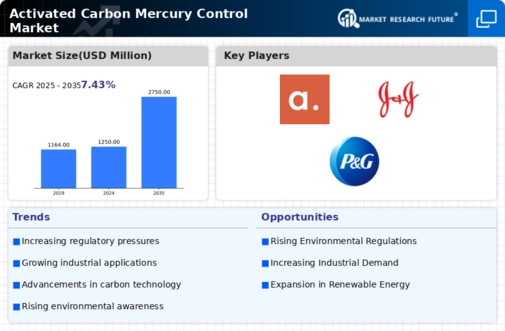Regulatory Compliance
The Global Activated Carbon Mercury Control Market Industry is significantly influenced by stringent environmental regulations aimed at reducing mercury emissions. Governments worldwide are implementing policies that mandate the use of advanced technologies for mercury control in various industries, including coal-fired power plants and waste incineration facilities. For instance, the U.S. Environmental Protection Agency has established regulations that require the installation of mercury control systems, thereby driving demand for activated carbon solutions. This regulatory landscape is expected to propel the market, contributing to its projected value of 1250 USD Million in 2024.
Market Growth Projections
The Global Activated Carbon Mercury Control Market Industry is projected to experience substantial growth, with estimates indicating a rise from 1250 USD Million in 2024 to 2750 USD Million by 2035. This growth trajectory reflects a compound annual growth rate (CAGR) of 7.43% from 2025 to 2035, driven by various factors including regulatory compliance, technological advancements, and increasing awareness of environmental impacts. As industries continue to adopt activated carbon solutions for mercury control, the market is poised for significant expansion in the coming years.
Technological Advancements
Innovations in activated carbon technology are a key driver for the Global Activated Carbon Mercury Control Market Industry. Continuous research and development efforts are leading to the creation of more efficient and cost-effective activated carbon products. For example, advancements in the activation process enhance the adsorption capacity of carbon, making it more effective in capturing mercury from flue gases. These technological improvements not only increase the performance of mercury control systems but also reduce operational costs for industries. As a result, the market is anticipated to grow at a CAGR of 7.43% from 2025 to 2035, reaching an estimated value of 2750 USD Million by 2035.
Increasing Industrialization
The rapid pace of industrialization across developing nations is a significant factor propelling the Global Activated Carbon Mercury Control Market Industry. As countries strive for economic growth, the establishment of new manufacturing and energy production facilities often leads to increased mercury emissions. Consequently, there is a heightened demand for effective mercury control technologies, including activated carbon systems. For instance, countries in Asia are witnessing a surge in coal-fired power plants, necessitating the implementation of mercury control measures. This trend is expected to contribute to the overall expansion of the market, as industries seek to comply with environmental regulations.
Investment in Clean Energy Technologies
The transition towards clean energy sources is a pivotal driver for the Global Activated Carbon Mercury Control Market Industry. Governments and private sectors are increasingly investing in renewable energy technologies, which often require efficient mercury control systems to minimize emissions during the energy generation process. For example, the integration of activated carbon solutions in biomass and waste-to-energy plants is becoming more prevalent as these facilities aim to achieve lower emissions. This investment trend not only supports the growth of the activated carbon market but also aligns with global sustainability goals, further enhancing the industry's prospects.
Growing Awareness of Environmental Impact
There is a rising global consciousness regarding the environmental and health impacts of mercury emissions, which is driving the Global Activated Carbon Mercury Control Market Industry. Public awareness campaigns and educational initiatives are highlighting the dangers of mercury pollution, prompting industries to adopt cleaner technologies. This shift is particularly evident in regions with high mercury emissions, such as Asia and North America, where companies are increasingly investing in activated carbon solutions to mitigate their environmental footprint. The growing emphasis on sustainability and corporate responsibility is likely to further fuel market growth in the coming years.















Leave a Comment